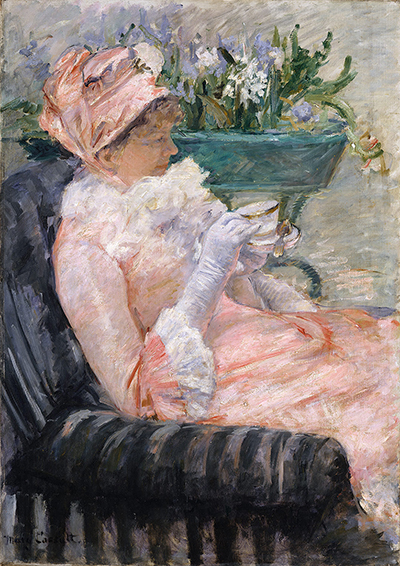The Cup of Tea is an oil painting by American artist Mary Cassatt. The painting depicts a young woman dressed in an elaborate pink and white gown sitting comfortably in a large dark blue armchair and holding a cup of tea in her hand.
Cassatt used her sister Lydia as a model for this work and many others, and would later produce a series of similar images of different women partaking in the same social activity. This particular work was completed in 1880 while Cassatt and her family were living in Paris, having moved there from their original home in America in 1877.
Cassatt's choice of subject for this work is notable because she would have seen scenes like this every day during her life as an upper-middle-class woman. Much of her work was focused around similar intimate scenes in the feminine sphere; her paintings and sketches often depicted women doing things like knitting, sewing, caring for children, and enjoying time in their gardens.
Many women painters of the time chose subjects like these because they were unable to leave their homes without someone (preferably a male guardian) to accompany them, so domestic scenes were a practical choice.
Unlike the stiff-looking portraits of women that male artists often created at the time, Cassatt's work shows her subject at ease and among her peers (even though they do not appear in the image). This type of candid scene could only have been captured by a woman's hand, and by making it into a work of art, Cassatt was able to immortalize a moment in time that might otherwise have been overlooked.
Though she was not as openly willing to ally herself with the feminist cause at this time as she would be later in her career, it is obvious that she recognized the value of the female experience and thought it worthy of celebration.
The Cup of Tea is also notable for its soft impressionist style. The brush strokes used to create it are soft and blend together to create a delicate look that perfectly suits the dainty scene. The fabrics of Lydia's dress are particularly well-rendered through this technique; the viewer gets a strong sense of the textural difference between the satin of her gloves and the frilly lace at her collar.
In terms of colour, the piece uses hues that are complementary to each other but still provide adequate contrast to maintain visual interest and distinct pieces like the armchair and the floral arrangement in the background. It is said that this is one of the main paintings that solidified Cassatt's affiliation with the French art world despite her American origins, and it remains an impressive piece even when set against some of her more polished later works.




